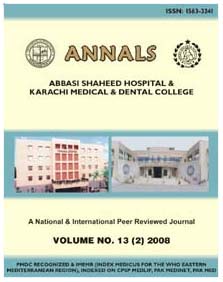
| |
| Home |
| Editorial Staff |
| Instruction to Authors |
| Journal-Issues |
| Policy |
| Copyright |
| TO COMPARE CHANGES IN SERUM ELECTROLYTES DURING TURP,
WHILE USING 5% DEXTROSE WATER AND GLYCINE AS IRRIGATION
FLUIDS IN TWO GROUPS.
*NIGHAT ABBAS, *SABAHAT TARIQ, *AKHTAR WAHEED KHAN, *GHULAM MURTAZA, *NADEEM NAQVI, *SHAKIR AHMED ABSTRACT Objective:To compare changes in serum electrolytes during TURP, while using 5% dextrose water and glycine as irrigation fluids in two groups. Design:Experimental study design Place and Duration of study: Department of Anaesthesiology, Liaquat National Hospital, Karachi, from January 2004 to Jun 2004. Patients and Methods: 60 ASA I and II patients who presented for TURP under spinal anaesthesia were divided in two groups. 30 patients were included in each group. Patients in group A received 5% dextrose water as irrigation fluid while patients in group B received 1.5% glycine as irrigation fluid. Serum electrolytes were checked preoperatively, intraoperatively at every 15 minutes interval and postoperatively every hour for 2 hours. Results:Serum Na+ level was decreased in both groups, but it was more marked in group A, maximum change being recorded at 45 minutes interval. These changes returned towards baseline with in 2 hours. Serum K+, C1 and HCO3 were also decreased in both the groups with more marked changes in group A. However, these changes were statistically insignificant. Conclusion:After comparing 1 .5% glycine with 5% dextrose water as irrigation fluids during TURP, we concluded that glycine was found to be better irrigation fluid as dextrose water causes more evident hypervolemia, hyponatremia and hemodilution than glycine. Key Words: 1 .5% glycine, 5% dextrose water, TURP syndrome, Hyponatremia, Irrigation fluid.
|
For Full text contact to:
|
|
* Department of Anaesthesia
|

Copyright © 2009 Abbbas Shaheed Hospital and Karachi Medical & Dental College.
All rights reserved.
Designed & Developed by: Creative Designers